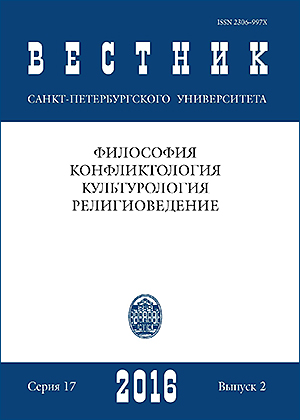GILLES DELEUZE ON INSTITUTION AND VIOLENCE
DOI:
https://doi.org/10.21638/11701/spbu17.2016.201Abstract
Th e general idea of the article is to compare Deleuze’s theory of the institution, which emerges in the context of various infl uences of French phenomenology and philosophy of law, with Searle’s theory and the latest Anglo-Saxon theories of the institution, and the new institutionalism. Deleuze carelessly diff erentiates infl uences and fragments copied or taken over from Hume, Saint-Just, de Sade, Renard, Hauriou, Durkheim, Malinowski and others and in the end completely succeeds in relegating to oblivion his ingenious project from 1953, Instincts and Institutions (Instincts et institutions). Th e consequences of such writing and theoretical work call into question the status of the theory of the institution and replace it with intuition and recognition that the thematisation of the institution is an impossible task. Th us the author of the article attempts to ‘integrate’ this impossibility to systematically think or explain the fi gure of institution into the framework of the great and pioneering work of Saint- Just, Hume, Deleuze, Gehlen and Searle. Deleuze’s main contribution to a future imaginary theory of the institution is the concept of a revolutionary institution as the result of reversal and sudden turning, the perverting of something, that happens within the institution. Deleuze uses l’institution révolutionnaire (revolutionary institution) in his texts, certainly completely aware that this phrase has a quite chaotic and vague history during postrevolutionary periods, but also that it is perfectly in the spirit of Saint-Just’s intentions. Institutions, free of laws, linking immobilising and moralising actions. Such pure institutions would be models of free actions, anarchic, in perpetual motion, in permanent revolution, in a constant state of immorality. Revolution is re-institutionalisation (or deinstitutionalisation) which includes diff erent forms of violence. Saint-Just detects two phenomena outside of institutions: terror and corruption. Hume discovers that violence has an advantage over the contract, and that in one way or another gives institutions their dynamic. Th anks to his mixture of these two diff erent registers, Deleuze outlines the transformation of violence into institutions: 1. Institutionalisation reveals the violence that precedes it and that it interrupts (raw violence or terror), as well as the violence opposed to it (corruption). 2. Violence is minimised in the process of institutionalisation because it is performed by all or the largest possible number of actors. 3. Th e violence of institutionalisation is violence in the process of conversion (Balibar), it is subsumed into the coercion of rules, into symbolic or institutional pressure. 4. Th e revolutionary institution supposes that there is no violence that has not been turned into the “body” of the institution, without remainder, and that therefore there is nothing outside of the institution. Refs 19.
Keywords:
Th eory of the institution, Revolution, violence, revolutionary institution (l’institution révolutionnaire)
Downloads
References
Downloads
Published
How to Cite
Issue
Section
License
Articles of "Vestnik of Saint Petersburg University. Philosophy and Conflict Studies" are open access distributed under the terms of the License Agreement with Saint Petersburg State University, which permits to the authors unrestricted distribution and self-archiving free of charge.






